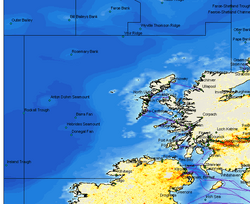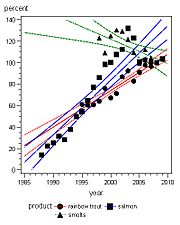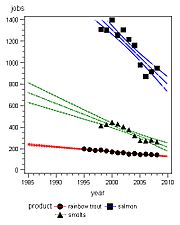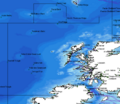Seas west of Scotland facts for kids
The "Seas West of Scotland" are an important area for fishing and marine life. This region includes not just the waters, but also the people and businesses living along the coast. It is a key area for how the European Union manages its seas, focusing on the unique geography, environment, economy, and communities.
Contents
Where Are the Seas West of Scotland?
This area does not have one single name. It includes smaller seas like the Malin Sea, the Inner Seas off the West Coast of Scotland, and the North Channel. It is mostly known as area VIa by the International Council for Exploration of the Sea. Its eastern edge is near Cape Wrath, and it stretches south to Donegal Bay. The border with the Irish Sea is near Stranraer. The countries next to these waters are Ireland, Northern Ireland, and Scotland. For the EU's marine strategy, this sea is part of the larger Celtic Seas, which are different from the Celtic Sea further south.
How Are These Waters Managed?
The UK's Marine and Coastal Access Act 2009 does not directly control the waters west of Scotland. This is because Scotland and Northern Ireland have their own local governments that manage these areas. The Scottish and Northern Ireland governments are working together on a "marine policy statement." This is a plan to help manage the sea. Their goal is to have this plan ready by November 2011.
Who Lives Near These Seas?
Most of the Scottish coast in this area has very few people. A big exception is the Firth of Clyde and the River Clyde. This area is home to Glasgow, a large city that was once famous for shipbuilding. Greater Glasgow has about 1.2 million people.
The main coastal town in Northern Ireland on this sea is Derry, with a population of 237,000. County Donegal in Ireland had about 137,575 people in 2002. Belfast is a bigger city and port, but it faces the Irish Sea.
Many people in the west of Scotland live in "remote rural" areas. This means they are more than a 30-minute drive from a town with 10,000 or more people. The population is not shrinking. Young people might leave for college or their first jobs. However, older people, often from other parts of the UK, move here to raise families. This helps keep the population stable.
What Languages Are Spoken?
This coastline is part of the Celtic region. Gaelic is a minority language spoken in many parts of the area. It is strongest in the Outer Hebrides and Tyrconnel in Donegal. Scottish Gaelic is becoming less common in Scotland. However, in Ireland, the Irish language is taught in schools, so most Irish people understand it. The Gaelic spoken in Donegal is special and similar to Scottish Gaelic.
Fishing in the Seas West of Scotland
Sea Fisheries
Over the last 15 years, there has been a big drop in fishing for groundfish (called demersal fish). Fishing for fish that swim in open water (called pelagic fish) has stayed about the same. However, fishing for Norway lobster (nephrops) has increased. Most of the pelagic and demersal fishing is done by boats from the North Sea. This means that nephrops fishing is the most important part of the fishing economy for ports on the west of Scotland.
New rules were put in place in 2009 for UK and Scottish fisheries. These included fewer days at sea for fishing boats. Fishermen said these rules affected their costs and how they fished. But their main worries were low prices and small quotas (limits on how much fish they could catch). Nephrops fishermen were very worried about low prices. Most believed this was due to the economy and not just the fishing rules.
It will take time for groundfish fishing to recover. Even with rules, cod is still caught too much. Haddock is also fished more than recommended. While anglerfish is profitable, scientists do not have enough data to know if its population is stable.
The nephrops fishery has grown in recent years. This has helped make up for the decline in whitefish. Scientists measure how much fish is caught as "fishing mortality." They suggest that for nephrops, the amount caught each year should be between 8.8% and 15.4% of the total stock. However, current fishing rates are often higher than this, which means they are not sustainable. This means too many nephrops are being caught.
It is unlikely that the fishing industry will make more money by catching more fish in the future. Experts expect pelagic catches to stay similar, groundfish stocks to not recover much, and nephrops catches to decrease.
Fish Farming (Aquaculture)
Scotland is the biggest producer of farmed salmon in the EU. It is the third largest in the world, after Norway and Chile. Scotland produces 80% of all farmed fish in the UK.
In 2007, Scotland produced nearly 130,000 tonnes of Atlantic salmon. They also farmed rainbow trout, cod, mussels, and oysters. The value of farmed fish in Scotland was about £346 million in 2007. Fish farming has grown a lot in recent years.
There is a plan for Scottish aquaculture to make the industry more competitive and sustainable. It also aims to improve how the public sees fish farming and how it is managed.
Wild Salmon
Wild salmon are very special fish. They travel from highland streams to feeding areas near Greenland. Their presence in Scottish rivers shows that efforts to protect aquatic environments are working. It is worrying that fewer salmon are returning to the rivers from the sea. This is happening even though fishing for them has been reduced.
Scientists believe most salmon die at sea, but they do not know why. Some ideas include:
- Farmed fish escaping or spreading diseases (though most salmon rivers are on the east coast, and most fish farms are on the west).
- Global warming (but salmon have survived similar temperature changes before).
- Being caught at sea (but few salmon are found in nets).
A large research project called SALSEA-Merge is studying this mystery.
Renewable Energy from the Sea
The waters west of Scotland are excellent for offshore renewable energy. They have very strong winds, fairly shallow water, and strong tides.
In 2009, companies were given rights to build wind farms in areas like Kintyre, Islay, and the Arran Array. These projects could produce a lot of electricity. More rights were given in 2010 for other UK coastal zones, but not in the waters west of Scotland.
A big challenge is that these energy sources are far from where people use electricity. This means power can be lost over long transmission lines. A report suggested that billions of euros would be needed to build lines to carry Scottish power south.
The long sea lochs on Scotland's west coast might also be good for storing energy. Even wind farms on land can affect the sea. Plans for a wind farm on the Isle of Lewis will need undersea cables. These cables might cross protected marine areas, so they will need special permission.
Ferry Services
Transport to the islands in the waters west of Scotland mostly relies on ferries. The company CalMac Ltd runs 26 routes. In 2006, they carried over 5 million passengers and more than 1 million cars. The Scottish government owns CalMac and gives it about £45 million each year. This money helps the company provide a vital service to these remote communities.
In 2009, the European Commission agreed that these payments were fair, except for one route. A review of the ferry services was done in 2009. The goal was to help all parts of Scotland grow, especially the most remote areas. No reports from this review have been made public yet.
Images for kids






